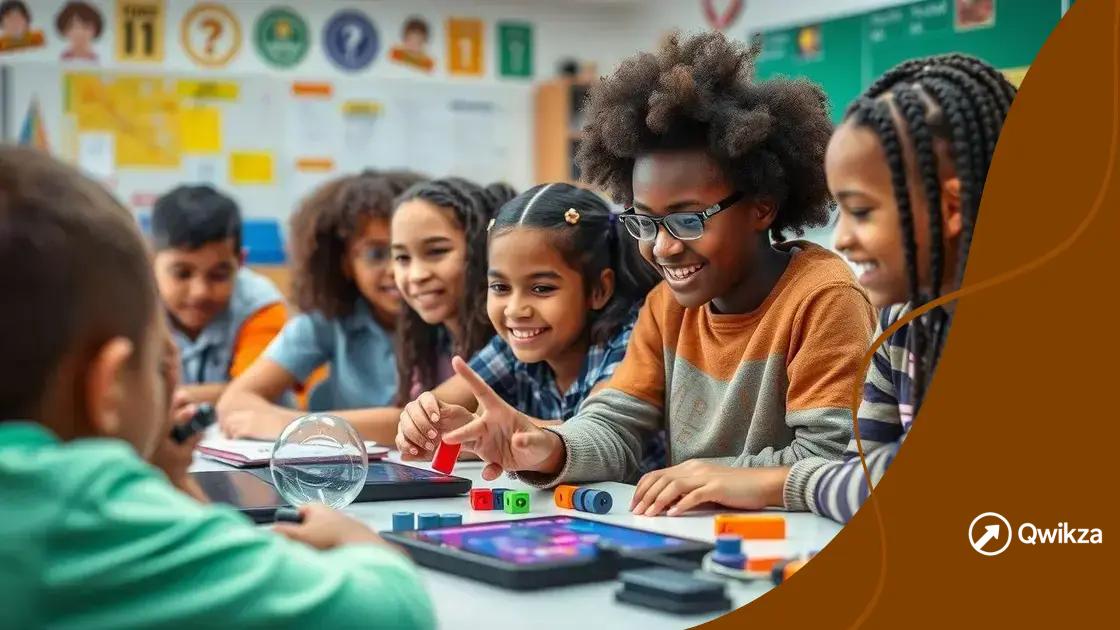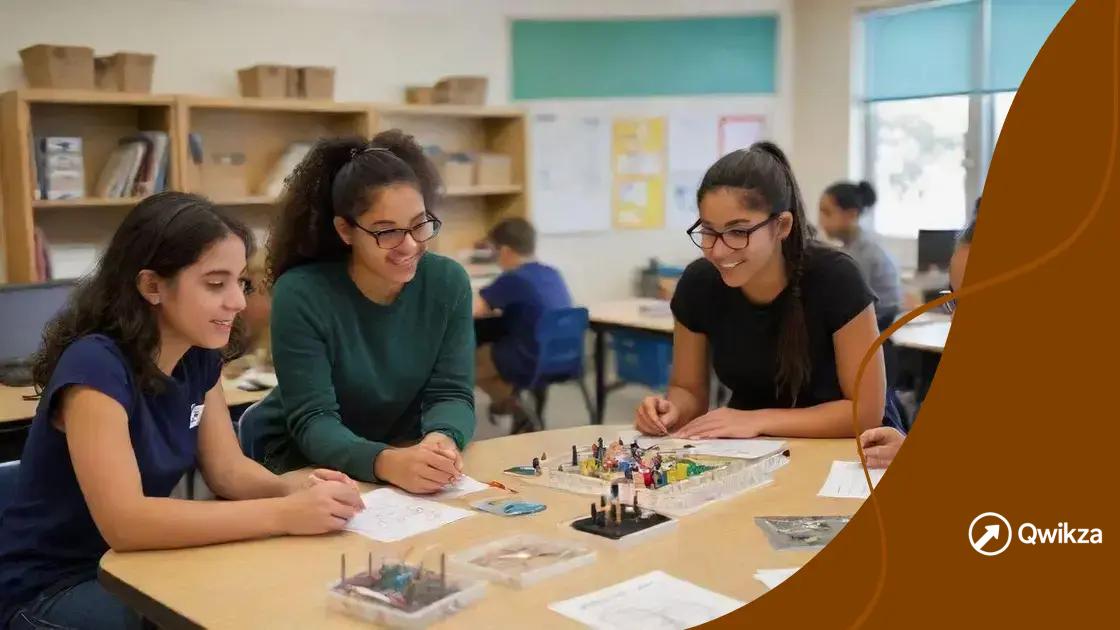Neurodiversity in e-learning: engaging gamified pathways

Neurodiversity in e-learning involves creating inclusive educational environments that leverage strategies like gamification, adaptive technology, and social-emotional learning to support diverse learners effectively.
Neurodiversity in e-learning is reshaping how we approach education, especially in STEM fields. Have you ever wondered how gamified experiences can enhance learning for everyone, regardless of their unique needs? Let’s dive into this transformative approach!
Understanding neurodiversity in education
Understanding neurodiversity in education is essential for creating a supportive learning environment. It means recognizing that every brain is unique and contributes to our learning ecosystem in different ways. This understanding allows educators to tailor approaches that meet diverse needs.
Importance of Recognizing Neurodiversity
Recognizing neurodiversity helps create more inclusive classrooms. It fosters a sense of belonging among students, encouraging them to participate and engage. When students see their differences valued, it boosts their confidence and academic performance.
- Enhances student engagement
- Promotes collaboration among peers
- Improves overall classroom dynamics
Moreover, it is vital for educators to understand how different learning profiles manifest. For instance, students with ADHD may thrive with hands-on activities, while those with autism often benefit from structured environments. By adapting teaching methods, we can better support individual strengths.
Understanding Learning Differences
Learning differences are not deficits; they are different pathways to learning. Embracing these paths means offering varied activities that cater to all students. For example, using technology can provide necessary accommodations and engage diverse learners.
Utilizing tools such as interactive simulations or gamified assessments allows for a more comprehensive learning experience. These methods not only cater to different learning styles but also encourage self-directed learning, empowering students to explore at their own pace. Understanding and implementing various instructional strategies fosters a culture of respect and appreciation for differences.
Ultimately, embracing neurodiversity in education leads to better outcomes for all students. It lays the foundation for innovative teaching strategies that can adapt to an ever-changing educational landscape.
The role of gamification in learning
The role of gamification in learning is both exciting and transformative. By incorporating game-like elements into education, we can make learning more engaging for students. This approach taps into students’ natural desires to compete, achieve, and collaborate.
Benefits of Gamification
Gamification brings numerous benefits that enhance the educational experience. It helps students feel more motivated and encourages active participation in their learning processes. When students can earn rewards or badges, they are more likely to stay focused and committed.
- Increases student motivation
- Encourages collaboration among peers
- Provides instant feedback on performance
In gamification, the use of game mechanics—such as points, leaderboards, and challenges—makes learning enjoyable. For instance, when students advance levels through quizzes or projects, they feel a sense of accomplishment. This excitement can foster a love for learning that lasts a lifetime.
Implementing Gamification Strategies
Educators can implement gamification strategies in many ways. Creating interactive lessons that include quizzes with point systems can be a great start. Additionally, educators can use technology, like educational apps, to facilitate this approach.
Offering challenges and competitions can spark a friendly spirit among students. Assignments that allow for teamwork can encourage peer interaction, enhancing social skills. As these elements are introduced, it is essential to tailor them to the specific needs of the learners.
Ultimately, when educators understand the value of gamification, they can create dynamic learning environments that not only engage but also empower students. By providing fun learning experiences, we can help students thrive academically and socially.
Strategies for creating inclusive STEM environments

Strategies for creating inclusive STEM environments are vital for ensuring every student has the opportunity to succeed. It is essential to foster a space where all students feel valued and engaged in the learning process. When these strategies are implemented, students from diverse backgrounds and abilities can thrive.
Creating Accessible Learning Spaces
One of the first steps in promoting inclusivity is to create accessible learning spaces. This means using a variety of teaching materials and resources to cater to different learning styles. For example, providing visual aids, hands-on activities, and interactive technology can enhance participation.
- Incorporate visual aids, like diagrams and videos
- Utilize hands-on experiments to engage learners
- Use interactive software that supports varied learning styles
Additionally, ensuring that physical spaces are accessible to all students, including those with physical disabilities, is crucial. Implementing flexible seating arrangements can allow students to choose environments where they feel most comfortable.
Fostering Collaboration and Communication
Encouraging collaboration among students is another effective strategy. Group projects allow students to work together, share ideas, and learn from one another. This not only enhances understanding but also builds essential social skills.
It’s important to create opportunities for open communication within groups. Teachers can facilitate discussions that allow all students to express their thoughts and ideas. When every voice is heard, students will feel more empowered and engaged in their learning.
Professional development for teachers is equally important. Training programs focused on inclusivity can help educators understand how to support diverse learners effectively. By equipping teachers with the right tools and methods, schools can create an environment that meets the needs of all students.
Real-world examples of success
Real-world examples of success in promoting neurodiversity in e-learning reveal the positive impact these initiatives can have on students. Across various educational settings, innovative strategies have resulted in meaningful outcomes that support all learners.
Success Story: Innovative School Programs
Some schools have created programs specifically designed to embrace neurodiversity. These programs often incorporate flexible teaching methods tailored to individual needs. In these environments, students report feeling more engaged and valued.
- Utilizing mentor programs connecting neurodiverse students with peers
- Incorporating visual aids and technology to enhance learning
- Creating sensory-friendly spaces
Such initiatives not only boost academic performance but also increase confidence and social skills among students. They provide positive experiences that can last a lifetime.
Corporate Training Initiatives
On the corporate side, many companies have developed training programs focused on neurodiversity. These programs aim to create inclusive workplaces that value diverse talents. For example, large tech firms have implemented hiring initiatives that actively seek neurodiverse candidates.
Training sessions educate staff about the strengths that neurodiverse individuals bring to the team. By promoting understanding and acceptance, these companies create a supportive work environment where everyone can thrive. This shows how applying neurodiversity principles outside traditional education brightens futures.
Overall, looking at real-world examples highlights the effectiveness of implementing strategies that embrace neurodiversity. They demonstrate that creating supportive environments fosters growth and success for everyone involved.
Future trends in neurodiverse e-learning
Future trends in neurodiverse e-learning are paving the way for even more inclusive education. As technology advances, schools and organizations are finding innovative methods to cater to diverse learners. This evolution aims to create personalized education experiences that meet individual needs.
Increased Use of Adaptive Learning Technologies
One major trend is the rise of adaptive learning technologies. These tools adjust content based on a student’s unique learning pace and style. This means that students can engage with material at their own speed, enhancing understanding and retention.
- Platforms that assess student performance in real-time
- Tailored content recommendations for each learner
- Interactive modules that adapt to user choices and feedback
Such technologies empower educators to provide specific support to students who might need it most, fostering a more inclusive classroom environment.
Greater Emphasis on Social-Emotional Learning (SEL)
Another trend is the growing emphasis on social-emotional learning (SEL). Understanding and managing emotions is critical for all students, especially those with neurodiverse backgrounds. Programs that focus on SEL help students develop communication skills and build empathy.
Integrating SEL into e-learning can help create safe online communities where students feel comfortable sharing their thoughts and experiences. Teachers can use virtual platforms to facilitate discussions, encouraging students to express themselves freely.
As the landscape of education continues to change, recognizing the value of diverse learning styles becomes more important. The future of neurodiverse e-learning promises to create more accommodating environments that celebrate differences, making learning accessible for everyone.
In conclusion, embracing neurodiversity in education is essential for creating inclusive learning environments that benefit all students. As we have seen, effective strategies like gamification, adaptive technology, and social-emotional learning play a crucial role in supporting diverse learners. By recognizing the unique strengths of each student, educators can foster a rich, collaborative atmosphere that not only enhances academic performance but also builds confidence and social skills. The future of neurodiverse e-learning looks promising, with innovative approaches that continue to shape a more equitable education system. Let’s strive to make every learning experience a positive one!
FAQ – Frequently Asked Questions about Neurodiversity in E-Learning
What is neurodiversity in education?
Neurodiversity in education refers to the understanding and acceptance of diverse brain types and learning styles, emphasizing the unique strengths of each student.
How can gamification enhance learning for neurodiverse students?
Gamification can make learning more engaging and motivating for neurodiverse students by incorporating game-like elements, such as rewards and interactive challenges.
What role does adaptive technology play in e-learning?
Adaptive technology personalizes learning experiences by adjusting content and pacing to meet the individual needs of students, fostering inclusivity.
Why is social-emotional learning important for neurodiverse students?
Social-emotional learning helps neurodiverse students develop essential communication and emotional regulation skills, creating a supportive and collaborative learning environment.
